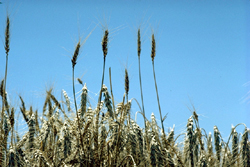World Wheat Economy: Difference between revisions
imported>David Tribe No edit summary |
imported>David Tribe No edit summary |
||
| Line 3: | Line 3: | ||
This article provides an outline of the geographical differences in wheat cropping practice, wheat trade and wheat economics in the main wheat growing regions of the world. | This article provides an outline of the geographical differences in wheat cropping practice, wheat trade and wheat economics in the main wheat growing regions of the world. | ||
==Overview of the global wheat trading system== | |||
==Wheat in China== | ==Wheat in China== | ||
Revision as of 21:15, 19 January 2007
This article provides an outline of the geographical differences in wheat cropping practice, wheat trade and wheat economics in the main wheat growing regions of the world.
Overview of the global wheat trading system
Wheat in China
Wheat in the EU
Wheat in the USA
In 1881, the Household Cyclopedia stated:
"Wheat may be classed under two principal divisions...The first is composed of all the varieties of red wheat. The second division comprehends the whole varieties of white wheat, which again may be arranged under two distinct heads, namely, thick-chaffed and thin-chaffed."
Thick-chaffed wheat varieties were the most widely used before 1799, as they make the best flour, and in dry seasons, equal the yields of thin-chaffed varieties. However, thick-chaffed varieties are particularly susceptible to mildew, and a widespread outbreak of mildew in 1799 began a gradual decline in the popularity of thick-chaffed varieties.
Five main classes of wheat are used in the USA today:
- Hard Red Spring — a hard, brownish, high protein wheat used for bread and hard-baked goods. This wheat accounts for about 25% of production, and is mainly grown in the Northern Plains (North Dakota, Montana, Minnesota, and South Dakota). It is valued for high protein levels, which make it suitable for specialty breads and blending with lower protein wheat. It is mainly traded at the Minneapolis Grain Exchange.
- Hard Red Winter — a hard, brownish, mellow high protein wheat used for bread, hard baked goods and as an adjunct in other flours to increase protein in pastry flour for pie crusts. Some brands of unbleached all-purpose flours are commonly made from hard red winter wheat alone. Accounts for about 40% of total production and is grown primarily in the Great Plains (Texas north through Montana). It is mainly traded by the Kansas City Board of Trade.
- Durum — a very hard, translucent, light colored grain used to make semolina flour for pasta.
- Hard White — a hard, light colored, opaque, chalky, medium protein wheat planted in dry, temperate areas. Used for bread and brewing, and is particularly good for making tortillas and Oriental noodles.
- Soft Red Winter — a soft, low protein wheat used for cakes, pie crusts, biscuits, and muffins. Amounting to 15-20% of total production, it is grown mainly in States along the Mississippi River and in the Eastern States. It is mainly traded by the Chicago Board of Trade
- Soft White — a soft, light colored wheat, that is very low in protein. It is grown in temperate moist areas, and is used particularly for pie crusts and pastry.
Hard wheats are harder to process and red wheats may need bleaching, so soft and white wheats usually command higher prices than hard and red wheats on the commodities market.

